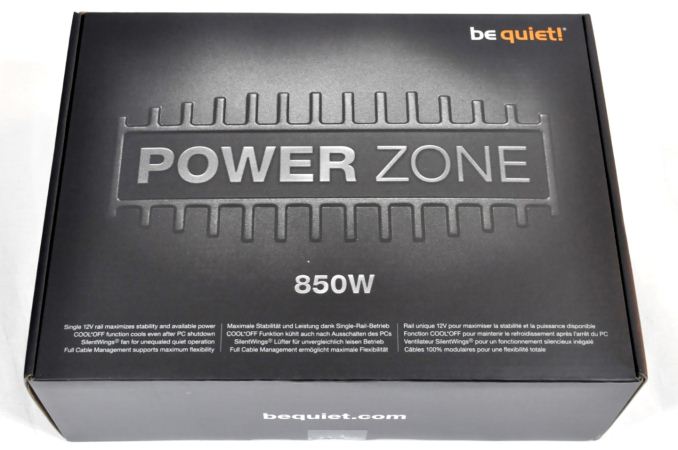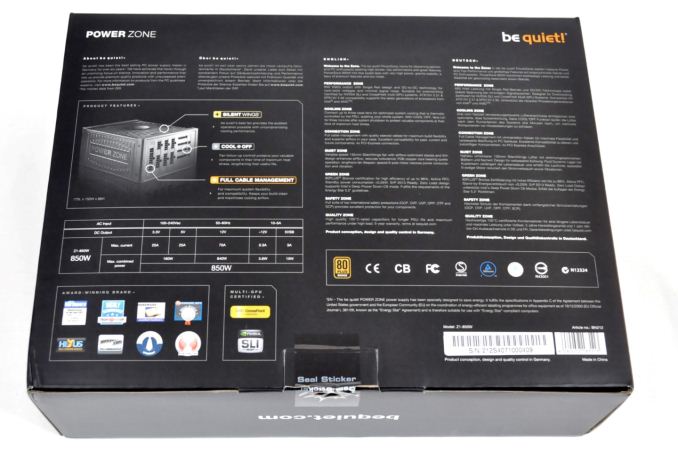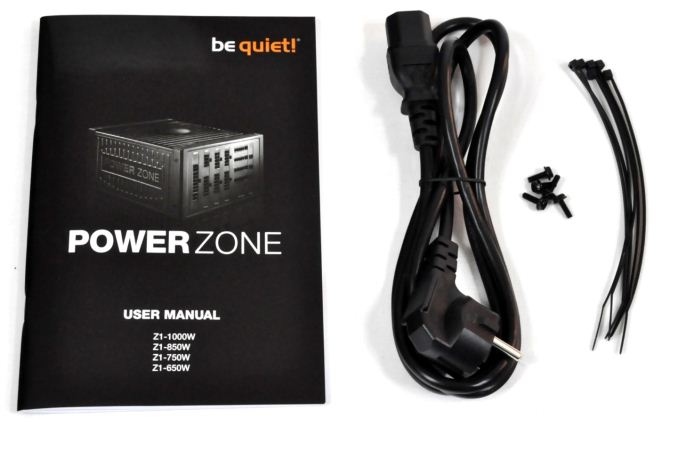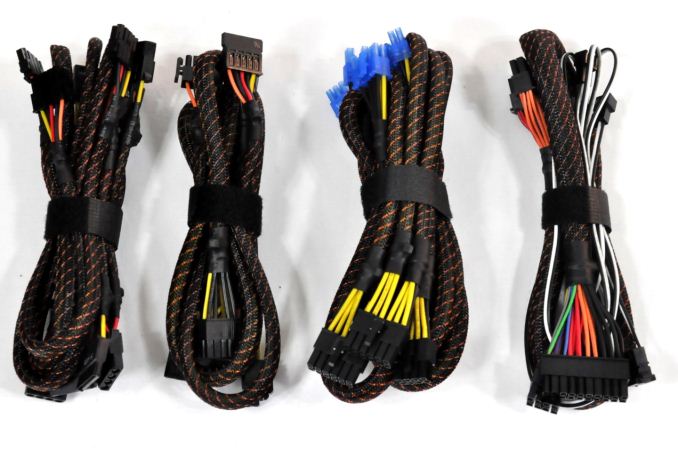be quiet! Power Zone 850W CM Power Supply Review
by E. Fylladitakis on August 14, 2014 6:00 AM EST- Posted in
- Cases/Cooling/PSUs
- PSUs
- be quiet!
- FSP
- Fortron/Source

Introduction
be quiet! is a German company that is slowly making their way into the North American market. As you might guess from the name, be quiet! specializes in low-noise computer PSUs and coolers. (And yes, if you're wondering, the exclamation point is part of the company name, and it's supposed to be all lowercase as well.) Although they currently have a large number of interesting products, we've only had a chance to review a few of their products. It's been some time since we last looked at any of their PSUs, but be quiet! has sent us their Power Zone 850W CM, one of their most popular products right now.
The Power Zone is be quiet!'s "Gaming" series, meaning that they are not meant to be top performers but balanced between high performance, aesthetics, and value. As the name of our sample suggests, it has a maximum output of 850 Watts at 50 °C and is a modular (CM = cable management) unit. It is also 80 Plus Bronze certified and covered by a 5-year manufacturer's warranty, which is good for a middle-range product. be quiet! has a very long and impressive list of features for this unit, which we will examine in this review. However, the most surprising part about the Power Zone 850W CM PSU is not its list of features but the retail price. At $159.99 plus shipping, it is one of the most expensive 850W units available, regardless of specifications. Does it really worth such a steep price tag? Read on to find out.
| Power specifications ( Rated @ 50 °C) | |||||
| AC INPUT | 100 - 240 VAC, 50 - 60 Hz | ||||
| RAIL | +3.3V | +5V | +12V | +5Vsb | -12V |
| MAX OUTPUT | 25A | 25A | 70A | 3.0A | 0.3A |
| 160W | 840W | 15W | 3.6W | ||
| TOTAL | 850W | ||||
Packaging and bundle
be quiet! supplies the Power Zone inside a sturdy cardboard box with a dark theme based on the series logo. The rear of the box has a short overview of the product, with adequate information about the unit and its features. We found the unit very carefully packed inside the box, protected by cardboard pieces, polyethylene foam slabs, and a cloth bag.
The bundle is minimalistic with only a manual, an AC power cable, a few cable straps, and black screws included. Note that these screws are longer than your typical M3 case screw and are necessary for the installation of the Power Zone 850W CM inside a case, as typical screws are not long enough.
The cables of the Power Zone 850W CM are all sleeved and with color-coded wires, yet the sleeving is not so typical. Instead of using plain black sleeving, be quiet! uses a dense sleeving with orange-red thread traces. The sole exception is the fan power cables, which use two plain black/white wires. Four cable straps hold the cable packs together and can be repurposed after the PSU has been installed inside a case.














20 Comments
View All Comments
inighthawki - Thursday, August 14, 2014 - link
Sorry, that should read:"whether or not to get a second *GPU*"
Daniel Egger - Thursday, August 14, 2014 - link
> 2) PSUs generally get their best efficiency while running at 50-60% load. So having a 750W PSU to power a 400W system provides the best efficiency. (Granted I realize for many this is a silly point, since the extra cost of the PSU itself generally will outweigh any cost savings, but maybe they like to be green, or just have the money)Your reasoning is flawed because a typical (even gamers) PC spends considerable amounts of time *way* below the maximum power rating where you'll immediately loose any advantage you would gain from having the maximum rating at the maximum efficiency point big time, especially if your system idles a lot and drops below the miraculous 20% mark.
But with a 400W system a few percent efficiency more or less really don't matter any more as there's definitely no greenness to be had anymore...
DanNeely - Thursday, August 14, 2014 - link
As a distributed computing (Boinc, primarily Einstein at home) participant, I suspect my system probably spends <95% of its operating time at full load; and my average load while gaming is probably below the non gaming average because the threshold where I have to GPU compute while playing to keep good FPS is lower than what's needed to heavily load the GPU. (Games and Compute are a lot worse at sharing GPU resources than their CPU equivalents.)inighthawki - Thursday, August 14, 2014 - link
Fair point.Flunk - Thursday, August 14, 2014 - link
It looks like they spent a good potion of the budget on appearance. Middling electronics and a loud fan don't impress me for the price. Some low end units are built better than this and I personally don't care what power supplies look like, in most cases you don't even see it.Essence_of_War - Thursday, August 14, 2014 - link
Sidenote on be Quiet's fans, is there some specific reason that they seem to use non-standard fan sizes? This unit uses a 135mm fan, and their HSFs are made for 130/135mm fans as well.DanNeely - Thursday, August 14, 2014 - link
For the PSU, it's the biggest size that will fit. Meaning that all else equal, it gives the most air movement for the least noise. On the heat sinks I'm not sure why they wouldn't just edge up to 140mm unless it's to exploit volume discounts from their supplier by using the same fans for both products.piroroadkill - Thursday, August 14, 2014 - link
I thought the 135mm fan in PSU thing was because Zalman has a patent on 140mm fans in power supplies.piroroadkill - Thursday, August 14, 2014 - link
Actually, I'm going to correct myself, because I don't think it's Zalman. I posted the same thing in 2011, and someone said it was HEC that has the patent.DanNeely - Thursday, August 14, 2014 - link
*BOGGLE*That's even more appalling than the "standard PC architecture feature on a smartphone" patents because I can't imagine any way that "use the biggest fan that will fit" could be obfuscated into something that a kindergartener, never mind a patent office reviewer, couldn't realize was trivial.